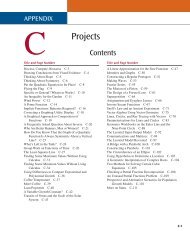HUsing ADO.NET 2.0 with Microsoft Access Databases - Cengage ...
HUsing ADO.NET 2.0 with Microsoft Access Databases - Cengage ...
HUsing ADO.NET 2.0 with Microsoft Access Databases - Cengage ...
You also want an ePaper? Increase the reach of your titles
YUMPU automatically turns print PDFs into web optimized ePapers that Google loves.
Self-Check Questions and Answers 43<br />
Appendix H C5779 39147 Page 43 07/10/06--JHR<br />
An XML schema definition file defines the tables and fields that make up<br />
the dataset.<br />
A query specifies the fields and records to retrieve from a database, as well as<br />
the order in which to arrange the fields and records.<br />
SQL stands for Structured Query Language, and is a set of commands that<br />
allows you to access and manipulate the data stored in databases.<br />
The SELECT statement is the most commonly used SQL command. It allows<br />
you to specify the fields and records you want to access from a database, as well<br />
as control the order in which the fields and records appear when displayed.<br />
You use the WHERE clause in a SELECT statement to limit the records that<br />
will be selected.<br />
You use the ORDER BY clause in a SELECT statement to control the order in<br />
which the records are arranged.<br />
Self-Check Questions and Answers<br />
1. The field that links a child table to a parent table is called the .<br />
a. foreign key in the child table<br />
b. foreign key in the parent table<br />
c. link key in the parent table<br />
d. primary key in the child table<br />
2. When using <strong>ADO</strong>.<strong>NET</strong> <strong>2.0</strong> to access the information contained in a<br />
database, the computer stores a copy of the information in a .<br />
a. databaseSet in internal memory<br />
b. dataset in internal memory<br />
c. dataset on the computer’s hard drive<br />
d. recordset on the computer’s hard drive<br />
3. The process of connecting a control to a dataset is called .<br />
a. assigning<br />
b. attaching<br />
c. joining<br />
d. None of the above.<br />
4. The object connects a database to a DataSet object.<br />
a. BindingSource<br />
b. DataBase<br />
c. DataGridView<br />
d. TableAdapter<br />
5. The property stores an integer that represents the location of the<br />
record pointer in a dataset.<br />
a. BindingNavigator object’s Position<br />
b. BindingSource object’s Position<br />
c. TableAdapter object’s Position<br />
d. None of the above.
















